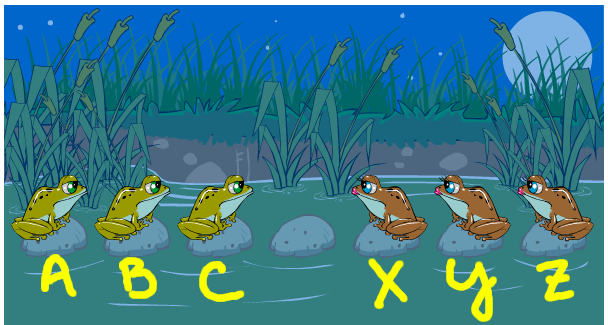Assignment 10 – AI
due in class on +40
(1) Use search to solve a puzzle
Six frogs are trying to cross a pond by jumping between stones. Alma, Ben, and Carl are heading East; while Xavier, Yolanda, and Zanjoe are heading West. Each frog can jump just onto an adjacent stone, or jump over another frog if there is an empty stone behind it. The frogs are stubborn, however, and are not willing to change direction.

We can represent the start state above as ABC-XYZ. Then the goal state would be XYZ-ABC. From the start state, there are four possible moves. This chart emulates the first part of the search graph:
Cslides:AB-CXYZ- Then
Bslides:A-BCXYZ- Then
Aslides:-ABCXYZand we’re stuck
- Then
- or
Ajumps:-BACXYZand we’re stuck - or
Xjumps:ABXC-YZ- Then
Cslides:ABX-CYZ… - or
Yslides:ABXCY-Z… - or
Zjumps:ABXCZY-and we’re stuck
- Then
- Then
Bjumps:A-CBXYZ- Then
Aslides:-ACBXYZand we’re stuck
- Then
Xslides:ABCX-YZ…Yjumps:ABCYX-Z…
On paper, expand the graph for the frog-jumping problem until you reach the goal state, but you can make two simplifications:
Just use four frogs, so the start state is
AB-YZand the goal isYZ-AB.There are always two ways to reach the goal: one starts with a frog (A or B) moving right, the other with a frog (Y or Z) moving left. So ignore the solutions starting with Y or Z. This will cut the search space in half.
Here’s a simple notation you can use:
ab-yz
b: a-byz
a: -bayz
y: (ignored)
z: (ignored)
a-byz
a: -abyz
y: ayb-z
-bayz
stuckI wrote a Frogs Python program that will solve this puzzle for any number of frogs.
(2) machine learning of decision tree
Space shuttle data – after opening (use IE or Chrome, not Firefox), log in to Google and select File » Make a copy. Then you should be able to filter the records by field values using the drop-downs in the column header.